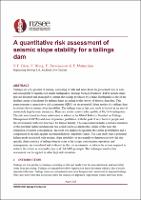A quantitative risk assessment of seismic slope stability for a tailings dam

Download
Date
2023-04-19Authors
Chen, Vis Yuanzhi
Wang, Yu
Torvelainen, Eric
Matuschka, Trevor
Metadata
Show full item recordAbstract
Tailings are a by-product of mining, consisting of silts and sands from the processed rock or soils and susceptible to liquefaction under earthquakes. Tailings Storage Facilities (TSFs) include dams that are designed and managed to contain the tailings produced by a mine. Earthquake is one of the leading causes of incidents for tailings dams according to the review of historic dam data. This paper presents a quantitative risk assessment (QRA) on the potential failure modes of a tailings dam in closure due to seismic slope instability. The tailings dam in this case study is located in an area of moderately high historic seismicity. There are nearby active faults capable of Mw>6.0 earthquakes. The risk assessment has been undertaken to adhere to the Global Industry Standard on Tailings Management (GISTM) and state-of-practice guidelines, with the goal of zero harm to people and the environment with zero tolerance for human fatality. The assessment includes a robust evaluation of the potential failure mechanisms that could lead to a catastrophic failure of the dam, the estimation of failure consequences, an event tree analysis to quantify the failure probabilities and a comparison of the risk against recommended risk tolerability limits. The case study uses a potential failure mode associated with seismic slope instability as an example to demonstrate how the site-specific characteristics of tailings dam in terms of its design, construction, operation, and management, are considered and evaluated in the risk assessment, to inform the actions required to achieve the as low as reasonably practical (ALARP) principle. The techniques used in this assessment can be applied in other high-risk industries.
